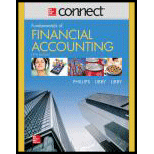
Comparing Options Using Present Value Concepts
After hearing a knock at your front door, you are surprised to see the Prize Patrol from a large, well-known magazine subscription company. It has arrived with the good news that you are the big winner, having won “$20 million.” You discover that you have three options: (1) you can receive $1 million per year for the next 20 years, (2) you can have $8 million today, or (3) you can have $2 million today and receive $700,000 for each of the next 20 years. Your financial adviser tells you that it is reasonable to expect to earn 10 percent on investments. Which option do you prefer? What factors influence your decision?
TIP: All three scenarios require you to determine today’s value of the various payment options. These are present value problems.
Want to see the full answer?
Check out a sample textbook solution
Chapter AC Solutions
Connect 1 Semester Access Card for Fundamentals of Financial Accounting
- Hi expert please give me answer general accounting questionarrow_forwardL.L. Bean operates two factories that produce its popular Bean boots (also known as "duck boots") in its home state of Maine. Since L.L. Bean prides itself on manufacturing its boots in Maine and not outsourcing, backorders for its boots can be high. In 2014, L.L. Bean sold about 450,000 pairs of the boots. At one point during 2014, it had a backorder level of about 100,000 pairs of boots. L.L. Bean can manufacture about 2,200 pairs of its duck boots each day with its factories running 24/7. In 2015, L.L. Bean expects to sell more than 500,000 pairs of its duck boots. As of late November 2015, the backorder quantity for Bean Boots was estimated to be about 50,000 pairs. Question: Assume another customer has returned a pair of duck boots (original cost $109) to L.L. Bean. What journal entry would L.L. Bean make to process the return and refund the original purchase price to the customer?arrow_forwardKreeps Corporation produces a single productarrow_forward
- A college's food operation has an average meal price of $9.20. Variable costs are $4.35 per meal and fixed costs total $95,000. How many meals must be sold to provide an operating income of $33,000? How many meals would have to be sold if fixed costs declined by 23%? (round to the nearest meal)arrow_forwardHiii tutor give me Answerarrow_forwardAnna company reported the following dataarrow_forward
